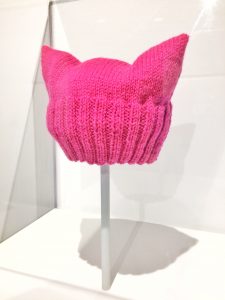
The cat-eared knit hat on view at Houston Center for Contemporary Craft this spring has traveled thousands of miles, from a Maine-based knitting group to New Jersey; Pennsylvania; Washington, D.C.; and now Houston. It was worn on January 21, 2017, in Washington, D.C., at the Women’s March, the largest single-day peaceful demonstration in United States history. Betsey Norland, a knitter from Lambertville, New Jersey, was unable to attend the protest herself and knitted eight hats as a way to participate, commenting, “A little bit of me was on a lot of women.” This handmade hat is just one of millions that were created for and worn by participants marching in Washington, D.C., and in 600 sister marches worldwide.
Jayna Zweiman and Krista Suh launched the Pussyhat Project with the aim of creating a united visual statement at the Women’s March through a “sea of pink.” The project connected people fighting for women’s rights around the world and provided knitting templates and videos to teach people how to crochet and knit. On the day of the Women’s March, the sweeping ribbon of pink hats worn by protesters visually united the over 5 million people who marched for women’s rights, LGBTQ rights, racial equality, immigration reform, healthcare reform, and a number of other issues following the inauguration of President Donald J. Trump. The project continues to be active, with a virtual Pussyhat March taking place on International Women’s Day, March 8, 2017.

The stitches that compose the pointed ears of the Pussyhat follow a long and deeply interwoven history of fiber and activism, a form of craftivism. Early 20th-century activists embroidered suffragette flags to support the movement for women’s right to vote in the United States and the United Kingdom. From 1918 to 1947, supporters of the Indian Independence movement used homespun cloth, called khadi, to resist the British monopoly on textiles. More recently, Brooklyn-based fiber artist Chi Nguyen initiated 5.4 Million and Counting, a community embroidery project, to resist the 2013 Texas omnibus anti-abortion bill. Tally marks, representing the number of women who would lose access to abortion and reproductive healthcare in Texas, were sewn by people across the country and brought together in a quilt that was displayed outside the Supreme Court in Washington, D.C., on March 2, 2016, where the restrictions were struck down. Craft artists continue to find new ways to subvert gender paradigms, enable community building, and serve activist movements.

